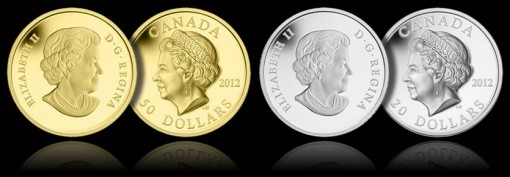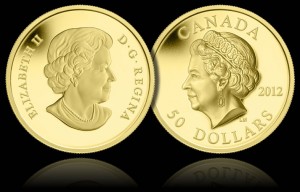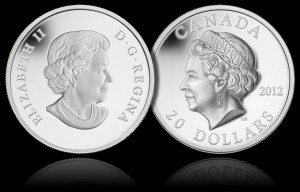In celebration of the Diamond Jubilee of Queen Elizabeth II, the Royal Canadian Mint in a second round of 2012 collector issues released two ultra-high relief proof coins entitled "The Queen’s Portrait."

The limited edition collectibles — a 99.999% fine $50 Gold Proof Coin and a 99.99% fine $20 Silver Proof Coin — are new additions to an array of other Diamond Jubilee keepsake coins from the Royal Canadian Mint. Queen Elizabeth II’s accession to the throne began in 1952, which makes 2012 the 60th anniversary. A variety of events have been scheduled in the celebration throughout the Commonwealth.
On the reverse of both proof coins is a contemporary effigy of the profile of Queen Elizabeth II by portrait artist Laurie McGaw. Inscriptions include CANADA, 2012, and the face value of the coins.
The obverse design is the 2003 effigy of Her Majesty Queen Elizabeth II by Susanna Blunt. Its inscriptions are ELIZABETH II and D G REGINA, which in Latin is an abbreviation that stands for "Elizabeth II, by the grace of God, the Queen."
As for prices on each of the proof coins, the Queen’s Portrait Pure Gold Ultra-High Relief $50 Coin runs for $2,999.99 CAD, and the Fine Silver Ultra-High Relief $20 Coin is $129.95 CAD.
2012 Ultra-High Relief $50 Gold Proof Coin – The Queen’s Portrait Diamond Jubilee – Specifications and Mintages

The $50 issue is the world’s first 99.999% pure gold strike in ultra-high relief proof quality. Only 500 will be produced, and the Canadian Mint has indicated sales are at 81% of maximum.
"This amazing coin was created through an innovative technique which pushes the apex of the design’s relief to extreme heights normally found only in medallic art," the Royal Canadian Mint reported. "Striking the purest gold in the world at such a high relief presented a mix of challenges and advantages due to the softness, malleability, and flow rate of gold. The result is an image of extraordinary height and fluidity in a rare coin limited to a world-wide mintage of 500."
Its total weight is 33.17 grams, and it has a diameter of 33 millimeters. The edges are serrated. A serialized certificate is included with the packaging which has the coin encapsulated and in a maroon flock-lined clamshell presentation case.
2012 Ultra-High Relief $20 Silver Proof Coin – The Queen’s Portrait Diamond Jubilee – Specifications and Mintages

Each silver strike is composed of 99.99% fine silver, also in ultra-high relief proof quality. RCM limited the production of these coins to 7,500.
The Mint describes states that the "$20 face value version of this coin design was quadruple-struck and hand polished to create coins which are individual works of art, given the minute differences in surface contours imparted by the extensive handcrafting of each coin."
With a weight of 30.75 grams and a diameter of 36 millimeters, the silver issues are slightly lighter and larger than their gold counterparts. Their packaging is similar in that they also come with a serialized certificate and a maroon flock-lined clamshell case.
The Queen’s Portrait proof coins may be purchased directly from the Royal Canadian Mint either online at www.mint.ca or by phone at the numbers 1-800-267-1871 (Canada); 1-800-268-6468 (US); and 613) 954-2626 (International).






Thank you for the article. I purchased the Ultra-High Relief $50 Gold Proof Coin and was amazed by its beauty. The high-relief effect gives the impression that the Queen is alive. One negative is the mint box. With a $2,999,99 CAD price tag they should have made something more fancy instead of using their standard box. Something similar to the UHRDE box from the US mint . BTW, the RCM is now reporting 92% sold out for this coin.
Something else from the Canadian MINT…
OTTAWA – Something will soon disappear from cash registers on both sides of the border. Ottawa says production of one-cent coins will be phased out starting this fall, although pennies will remain as legal tender. Finance Minister Jim Flaherty says the business sector views pennies as a nuisance. By halting production, Ottawa will save 11-million dollars a year because it costs 1.6-cents to produce one penny.